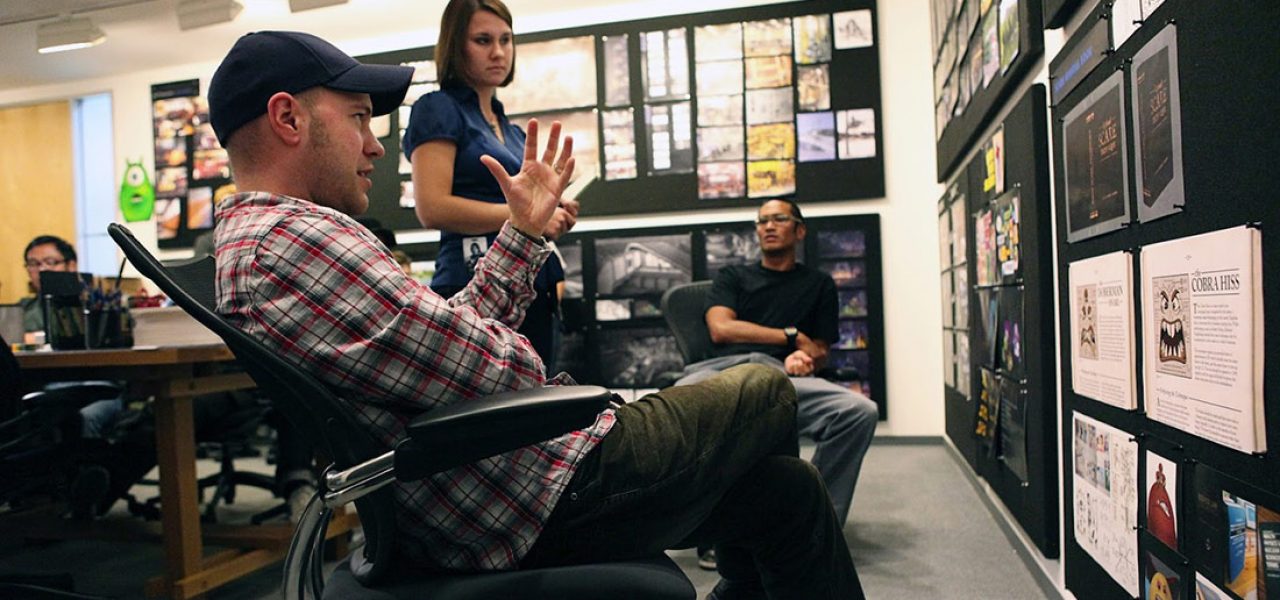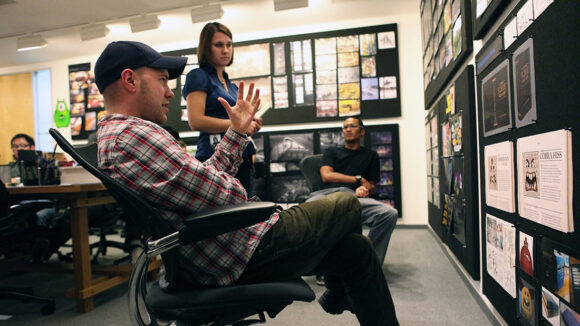

Former Pixar Artist Cassandra Smolcic Speaks Out About The Studio’s ‘Sexist,’ ‘Vulgar’ And ‘Unprofessional’ Culture
Cassandra Smolcic, a graphic designer who worked at Pixar Animation Studios for five years, has become the first woman to go on the record about disgraced former chief creative officer John Lasseter, with her full name attached.
In a brave 12,500-word essay entitled “Pixar’s Sexist Boys Club” — read the full essay here — she goes into disturbing and revealing detail about the toxic work environment at the Disney-owned Emeryville, California animation studio, and with the clarity and perspective of time, reflects on how she might have handled the situations differently.

Smolcic, pictured at the top of this post with Monsters University director Dan Scanlon (left) and production designer Ricky Nierva (right), earned credits on that film, as well as Toy Story 3, Cars 2, Brave, and other studio projects like The Blue Umbrella and Toy Story of Terror. Her time at the studio was anything but happy though. “I know people are saying that the climate there wasn’t ‘that bad,'” she writes. “I’m here to tell you that it was, and more than likely still is.”
She starts her story with a lot of personal history, which is important to set the stage. Smolcic makes clear that she believed that these early life experiences would be in her past after she was hired at the world’s most revered animation studio, a bastion of creative achievement filled with professional artists. Instead, to her surprise, she discovered a sexist fraternity existed at Pixar thanks to the company’s established culture of tolerance for bad behavior. On top of that, her career was impeded at every turn thanks to the established order of male dominance.
Literally on her first day on the job, she got a taste of what was waiting for her when she was warned by multiple men and women that Pixar head John Lasseter “could be touchy-feely with members of the opposite sex; that he had a tendency to make sexually charged comments to and about women; that interactions with him were often uncomfortable or even mortifying for female Pixarians.”
It got worse from there. Smolcic catalogs a staggering array of vulgar, disrespectful, lecherous, and physically abusive behavior at Pixar. If this is one woman’s experience, one truly shudders to think of the collective stories that have yet to be told about male-female relations at the studio.
Here’s just a few of the lowlights:
- Smolcic talks extensively about an Eastern European production designer at the studio — it isn’t that hard to figure out who this is — who sounds like a really awful human being and yet has been employed there for years despite vocal complaints by women:
“He goes on rants all the time about how he thinks American women are revolting, unattractive and sloppy in comparison to the beautiful creatures from his part of the world,” said one of the female artists who’d worked under the production designer (the chief artist who directs and manages all the visual aspects of a film). “But trust me, that won’t stop him from hitting on you.” Much like John, this man’s female targets had been reporting his vulgar, unprofessional behaviors for years, but his position and demeanor remained much the same. She instructed me to avoid him and do my best not to land a spot on his team.
During week two of my internship, I was making tea in one of the company kitchens when the production designer I’d been warned about approached me to introduce himself. When I told him my name, he said, “I already know who you are,” with a sideways grin while he looked me up and down with predatory volition, insinuating that my reputation preceded me. When he said he recognized my surname and my look from his part of the world, the hair all over my body stood up on high alert. He told me he was excited to finally have a beautiful face from his motherland in the studio.
I smiled and nodded, said nice to meet you and scampered off down the hall so fast I burnt my hand with hot tea. Even though his intended compliment creeped me out, in some ways I felt relieved that I was “his type” and might dodge the insults and bullying that he was known to dish out to women he didn’t find attractive. When I turned the corner to my office I peeked back down the hall. Sure enough, he was still standing exactly where I’d left him, watching me walk away with wolf-like intensity.
- Smolcic describes how she she was uninvited from production meetings because John Lasseter was unable to “control” himself around her:
“We’ve decided it’s best if you don’t attend art reviews on this production,” [the female art department manager] announced, looking over the wall of my cubicle. “John has a hard time controlling himself around young pretty girls, so it will be better for everyone if we just keep you out of sight,” she said with a shoulder shrug, referring to our film’s director and the company’s CCO. Before I had a chance to respond, her floating head disappeared.
My face flushed red hot with shock, then disappointment, then rage. At the time, I’d never formally been introduced to the animation demigod. But true to his reputation, just about every time I passed the well-known director on campus — who was always being whisked from point A to B by an entourage of eager assistants, sidekicks and wranglers — he would look me up and down with the cheek-to-cheek grin of a Cheshire Cat and the jovial, carefree strut of a powerful man who knew he pretty much owned the place.
When the day of our next art review arrived I watched in stone silence as the big man himself walked past my cubicle with his entourage in tow, the rest of the art department already waiting inside for his arrival. As the door, which was just three feet in front of my desk, slammed shut behind them, it felt like a proverbial door was closing on my career.
- Holidays at Pixar were another opportunity for Lasseter to misbehave in full view of all of the studio’s employees:
The entire Pixar workforce witnessed the sleazy spin John brought to the studio’s annual Halloween bash. Quite a few of my female friends refused, year after year, to enter the costume contest — even if they’d worked for hours on a prize-worthy outfit — because of how infamously uncomfortable the costume parade became. If Lasseter found a woman attractive when she got on stage, he’d ask her to repeatedly spin around or bombarded her with suggestive comments, turning the event into yet another lewd spectacle. These very public displays were so cringeworthy and inappropriate (to not only the women who braved the stage but also to the general audience) that the company eventually asked a lead animator to take over as the master of ceremonies.
- An unnamed director at the studio compared making films to trying to bang a woman:
Lasseter’s open sexism set the tone from the top, emboldening others to act like frat boys in just about any campus setting. I’ll never forget the day a director compared his latest film to “a big-titted blond who was difficult to nail down” in front of the whole company, a joke that received gasps of disapproval.
- Smolcic describes being physically assaulted by another Pixar employee:
Not surprisingly, tactless behavior towards women had a way of trickling all the way down through the ranks. About halfway through my time at the studio, I had a more intimate, disturbing physical encounter with a brazen male employee from outside my department. During an after-work celebration at one of Pixar’s employee-run bars, the coworker smacked and then grabbed my ass with a considerable amount of force while I was waiting for a volunteer bartender to make me a drink. Like a deer in headlights, I froze until my violator stumbled drunkenly away from me. The bar was loud, low-lit and filled shoulder-to-shoulder with intoxicated employees. I looked around, but no one seemed to have noticed what had just happened.
- The studio operates like a fraternity, Smolcic says, in which contributions by men are privileged over women’s work:
Most of us knew what it was like to be excluded from lively conversations that would fall silent when we entered conference rooms or offices that were dominated by men. We’d worked for and alongside male leaders who would interrupt or talk over us, who wouldn’t acknowledge our presence in the room or repeatedly passed us over for projects and opportunities, while guys in our departments were often given more work than they could handle. We often made light of our similar experiences with men who got nervous — or just plain awkward — with us in a given workday, and sometimes laughed together about the lack of charisma and social skills that many of our “manolescent” counterparts in Hawaiian shirts and graphic tees had in common.
We each formed our own strategies for facing a system designed to protect male leads at all costs; men who often treated us like outsiders or objects. Determined to remain part of one of the world’s most visionary companies, many of us kept silent about these disheartening experiences, because we understood that the price for speaking out was high.
Female leads were often forced into no-win situations, either suppressing their abilities — in order to make men feel more comfortable — or taking charge and risking being labeled “difficult” or “unlikable.”A female lead in my department once begged her bosses to bring on more artists to help her with a challenging, long-term production project. Her superiors repeatedly ignored her requests, until the stress of the job led her to psychological and physical breakdown. When she went on sabbatical to recover, her male replacement was given a team of half a dozen artists to help him complete the same task.
- Smolcic, who worked on Brave, also believed the firing of its original director Brenda Chapman to be unjustified:
To the general population of the studio — many of whom had never worked on Brave because it was not yet in full-steam production — it seemed as though Brenda’s firing was considered justifiable. Rumor had it that she had been indecisive, unconfident and ineffective as a director. But for me and others who worked closely with the second-time director, there was a palpable sense of outrage, disbelief and mourning after Brenda was removed from the film.
One artist, who’d been on the Brave story team for years, passionately told me how she didn’t find Brenda to be indecisive at all. Brenda knew exactly what film she was making and was very clear in communicating her vision, the story artist said, and the film she was making was powerful and compelling.
The piece is a difficult read, but it’s also one of the most important pieces written to date on the workplace culture of Pixar. While the behavior that Smolcic describes probably isn’t unique to Pixar, and one could perhaps find similar behavior at other animation studios, it’s particularly disheartening to hear of such things happening at Pixar, a company that profits from making films that emphasize family values and moral behavior. Lasseter and many of the company’s employees have clearly not practiced what they preach to audiences.
Smolcic correctly says that, “[D]ismantling John’s legacy will take more than just replacing a single executive or releasing an article about the female contributions to a given film. Such deeply ingrained biases require deliberate, conscientious effort to identify and dismantle.”
So, while replacing Lasseter with Pete Docter as head of the studio’s creative affairs is a step forward, it’s important to note that Disney CEO Bob Iger still hasn’t done anything to address Pixar’s gross failure of leadership that normalized this atrocious behavior and allowed the sexist boys’ club to flourish for so many years — and possibly even still right now.
It’s time to start asking the tough questions from the people who have running the studio for all of these years, namely Walt Disney and Pixar Animation Studios president Ed Catmull and Pixar Animation Studios president and general manager Jim Morris. Until the people responsible for allowing the behavior described in Smolcic’s piece are held accountable, it’s difficult to see how Pixar can regain its footing and move into the future as a healthy creative enterprise.

.png)